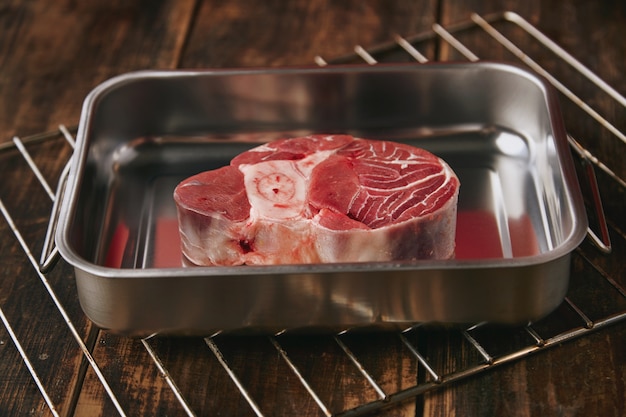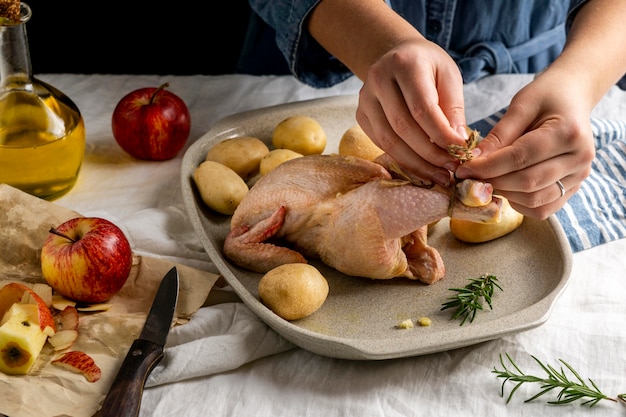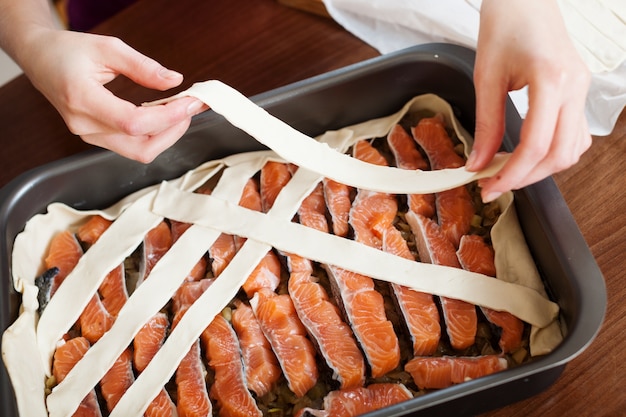There's something about a perfectly cooked filet mignon that just screams "special occasion." It's the kind of dish that makes you feel like you're dining at a fancy restaurant, even if you're just having it at home. Remember that time you had filet mignon at that fancy new bistro downtown? It was divine, wasn't it? And let me tell you, after years of experimenting in the kitchen, I've finally cracked the code to getting that succulent, melt-in-your-mouth texture every single time. So, grab your aprons, my culinary comrades, because we're about to embark on a journey to filet mignon perfection.
(Part 1) choosing the right cut: The Foundation of Success

You can't have a great filet mignon without a great cut of meat. It's like trying to build a house on shaky ground – you're setting yourself up for disappointment! Now, I'm not going to bore you with a science lesson on muscle fibers and marbling, but trust me, the quality of your meat matters. You want to aim for a cut that's at least 1 inch thick, with good marbling – those beautiful white streaks of fat that give the steak its flavour and tenderness. Think of it as a luxurious treat for your taste buds.
Where to Find the best filet mignon
You can find decent filet mignon at most supermarkets, but if you're looking for something truly special, head to a butcher shop. A good butcher can guide you to the perfect cut, taking into account your preferences and the occasion. Just the other day, I was at my local butcher shop, and he recommended a beautiful piece of filet mignon for a special dinner party I was hosting. He even trimmed it perfectly for me, so it was ready to go straight into the oven. He's like a culinary artist!
Choosing the Right Grade
You'll often see labels like "Select," "Choice," and "Prime" on filet mignon. These labels indicate the quality of the meat, with "Prime" being the highest grade. It means the meat is the most tender and flavourful. Of course, this also means it'll be the most expensive. But hey, sometimes you just gotta treat yourself! A little indulgence never hurt anyone, right?
(Part 2) Prepping for Perfection: Bringing the Filet Mignon to Room Temperature

Don't be tempted to throw your filet mignon straight from the fridge into the oven. It's like asking a swimmer to jump into a freezing lake without warming up – not a good idea! Bringing the meat to room temperature is essential for even cooking. It allows the heat to penetrate the meat more evenly, resulting in a more tender and juicy steak.
How Long to Leave the Meat Out
The general rule of thumb is to leave the filet mignon out for about 30-45 minutes before cooking. But, you can always check the temperature with a meat thermometer. It should reach around 55-60 degrees Fahrenheit (12-15 degrees Celsius). Remember, you want to bring it to room temperature, not let it get warm to the touch. Think of it as a gentle warm-up for your culinary star.
Why This Makes a Difference
You might be thinking, "Why go through all this hassle?" Well, imagine you're cooking a large pot of pasta. You wouldn't throw a cold pasta noodle into boiling water, would you? It would cook unevenly and probably end up mushy. The same principle applies to filet mignon. Bringing it to room temperature helps it cook more evenly and prevents the outside from burning before the inside is cooked through. It's all about achieving that perfect balance of texture and flavour.
(Part 3) Seasoning with Care: A Simple Approach to Big Flavour

Now, this is where the fun begins. Don't be afraid to experiment with your seasonings, but remember, sometimes simple is best.
Salt and Pepper: The Classics for a Reason
I always start with a generous sprinkle of kosher salt and freshly ground black pepper. It's a classic combination that enhances the natural flavours of the meat. I find that using kosher salt creates a beautiful crust on the filet mignon, while freshly ground pepper adds a touch of spiciness. You can also add a touch of garlic powder and onion powder for an extra kick. Just a sprinkle is all you need to elevate the flavour profile.
Herbs and Spices for a Flavorful Twist
If you want to get fancy, try adding a sprinkle of dried herbs like rosemary, thyme, or oregano. A pinch of smoked paprika can add a smoky depth to the flavour. But remember, less is more! You don't want to overwhelm the delicate flavour of the filet mignon. Just a subtle hint of spice is all you need to create a symphony of flavours.
A Quick Note on Seasoning Timing
You can season the filet mignon right before you put it in the oven, but I prefer to season it earlier. The salt has time to draw out moisture and create a delicious crust. But, if you're short on time, seasoning right before cooking is perfectly fine. Just make sure to distribute the seasoning evenly, so that every bite is infused with flavour.
(Part 4) The Oven-Baking Process: Mastering the Art of Heat Control
Now that your filet mignon is prepped and seasoned to perfection, it's time for the grand finale – the oven bake. Don't worry, it's simpler than you think! It's all about understanding the power of heat and how it interacts with your culinary masterpiece.
The Importance of Preheat
Firstly, preheat your oven to 400 degrees Fahrenheit (200 degrees Celsius). This is crucial for ensuring even cooking. Think of it like setting the stage for your culinary masterpiece. You wouldn't put on a play without warming up the stage lights, would you?
The Power of a Baking Sheet
Place your filet mignon on a baking sheet. You can use a plain baking sheet or a sheet lined with parchment paper. This will help prevent the meat from sticking to the pan. It's also good practice to put a small rack on top of the baking sheet to ensure even airflow around the meat. This little trick helps to create a more evenly cooked filet mignon.
A Quick Tip: A Little Oil for a Beautiful Crust
Before you pop the filet mignon in the oven, brush it with a little bit of olive oil. This will help create a beautiful golden-brown crust and prevent the meat from drying out. Think of it as a little pampering for your steak before it takes its trip to the oven.
(Part 5) Setting the Right Temperature for Your Desired Doneness
Now, here's where it gets interesting. You want to cook the filet mignon to your desired level of doneness. This is where knowing your meat temperature is vital. It's like finding the sweet spot for your culinary creation, where tenderness and flavour meet.
A Cheat Sheet for Doneness
Use a meat thermometer to ensure your filet mignon is cooked to perfection. Here's a handy guide to the internal temperatures:
| Doneness | Internal Temperature (°F) | Internal Temperature (°C) |
|---|---|---|
| Rare | 125-130 | 52-54 |
| Medium-Rare | 130-135 | 54-57 |
| Medium | 140-145 | 60-63 |
| Medium-Well | 150-155 | 65-68 |
| Well Done | 160 | 71 |
Remember, these are just guidelines. Everyone has their own preferences when it comes to doneness. Some people love a juicy, rare steak, while others prefer a well-done steak. It's all about personal taste.
(Part 6) Baking Time: Finding the Sweet Spot
Now that you know the desired temperature, it's time to talk about baking time. The baking time for a filet mignon will vary depending on its size and thickness. But, here's a general guide:
A Rough Estimate for Baking Time
For a 1-inch thick filet mignon, you can expect to bake it for about 10-15 minutes for rare, 15-20 minutes for medium-rare, 20-25 minutes for medium, and 25-30 minutes for medium-well.
Checking the Meat Temperature
I always recommend using a meat thermometer to check the internal temperature, especially if you're new to cooking filet mignon. You don't want to overcook it, so it's better to err on the side of caution. Overcooked filet mignon can be dry and tough, and nobody wants that!
(Part 7) Resting is Key: Giving the Filet Mignon a Chance to Relax
Once the filet mignon has reached your desired temperature, take it out of the oven and let it rest for at least 5-10 minutes before slicing and serving. This might seem like a silly step, but it's crucial for achieving that perfectly juicy and tender steak.
Why Resting is Essential
While the filet mignon is in the oven, the juices are pushed to the center. When you slice into it immediately, those juices run out, resulting in a dry steak. Resting allows the juices to redistribute throughout the meat, making it more tender and flavorful. Think of it as giving your culinary masterpiece a chance to breathe and relax before it's presented to the world.
How to Rest the Meat
Cover the filet mignon loosely with foil and let it rest on a cutting board. Resist the urge to cut into it too soon! Trust me, it'll be worth the wait. The extra few minutes of rest will make all the difference.
(Part 8) Slicing and Serving: Presenting Your Masterpiece
After resting, it's finally time to enjoy the fruits of your labor. Slice the filet mignon thinly against the grain, which will help make it even more tender. This means slicing perpendicular to the muscle fibers.
Garnishing Your Creation
Get creative with your garnishes! I love a simple sprinkle of fresh parsley or a sprig of rosemary. You can also add a dollop of butter, a drizzle of balsamic glaze, or a sprinkle of sea salt flakes. The possibilities are endless!
The Perfect Accompaniments
No filet mignon is complete without the right accompaniments. I like to pair it with roasted vegetables, creamy mashed potatoes, or a light salad. You can also serve it with a rich red wine sauce or a simple Dijon mustard sauce. It's all about creating a balanced and satisfying meal that will leave your guests wanting more.
FAQs
Q: What if I don't have a meat thermometer?
If you don't have a meat thermometer, you can use the "finger test" to estimate the doneness of the filet mignon. Press the meat with your finger. If it feels firm and springs back, it's well done. If it feels soft and springs back slowly, it's medium-well. If it feels soft and doesn't spring back, it's medium. If it feels very soft and doesn't spring back at all, it's medium-rare. If it feels very soft and wobbly, it's rare. But remember, this is just an estimate, and using a meat thermometer is always the most accurate way to check the doneness.
Q: Can I cook filet mignon in a cast iron skillet?
Absolutely! You can cook filet mignon in a cast iron skillet, which will give it a beautiful crust. Simply heat the skillet over medium-high heat and sear the filet mignon for 2-3 minutes per side. Then, transfer it to a preheated oven at 400 degrees Fahrenheit (200 degrees Celsius) and bake for 5-10 minutes, depending on your desired doneness. This method is a great way to achieve that perfect sear and crispy exterior.
Q: How do I store leftover filet mignon?
Leftover filet mignon can be stored in the refrigerator for 3-4 days. Simply wrap it tightly in plastic wrap or aluminum foil. You can also freeze leftover filet mignon for up to 3 months. To freeze, wrap it tightly in plastic wrap, then in aluminum foil. When you're ready to eat it, thaw it in the refrigerator overnight. This way, you can enjoy your culinary masterpiece for days to come.
Q: Can I use any type of beef for this recipe?
While filet mignon is the perfect choice for this recipe, you can substitute other cuts of beef, such as ribeye or new york strip. Just be aware that these cuts may require a slightly longer cooking time. It's all about adapting to the situation and finding the right cut for your culinary journey.
Q: What are some other tips for cooking the perfect filet mignon?
Here are a few more tips for cooking the perfect filet mignon:
- Don't overcrowd the pan. If you're cooking multiple filet mignons, make sure there's enough space between them to allow for even cooking. This will ensure that each steak cooks evenly and doesn't steam instead of sear.
- Let the pan get really hot before adding the meat. This will help create a nice sear. A hot pan is crucial for achieving that beautiful, crispy crust.
- Don't overcook the meat. Filet mignon is best cooked to medium-rare or medium. Overcooked filet mignon will be dry and tough. It's all about finding that delicate balance between tenderness and flavour.
There you have it! The secrets to creating the perfect oven-baked filet mignon are all yours. So, gather your ingredients, put on your chef's hat, and get ready to impress yourself and your guests with this culinary masterpiece. Remember, it's not just about the recipe, it's about the experience. Enjoy the process and the delicious results!
Everyone is watching

Corn on the Cob: The Ultimate Guide to Perfectly Cooked Ears
Healthy MealsAh, corn on the cob. Just the name evokes images of sunny days, barbecues, and that sweet, juicy flavour that ...

Perfect Pork Roast Oven Cooking Time: A Guide to Delicious Results
Healthy MealsThere's something truly satisfying about a perfectly roasted pork. The aroma alone is enough to make your mout...

Ham Cooking Time: How Long to Bake, Smoke, or Boil a Delicious Ham
Healthy MealsAh, ham. It's a classic, isn't it? A real crowd-pleaser, especially around holidays. And when done right, it'...

Scallops: The Ultimate Guide to Perfect Cooking
Healthy MealsAh, scallops. Those delicate, sweet, and utterly delicious morsels of the sea. They hold a special place in my...

Spaghetti Squash: The Ultimate Guide to Cooking and Serving
Healthy MealsRemember that time you saw spaghetti squash at the supermarket, looking all bumpy and strange, and thought, "W...
